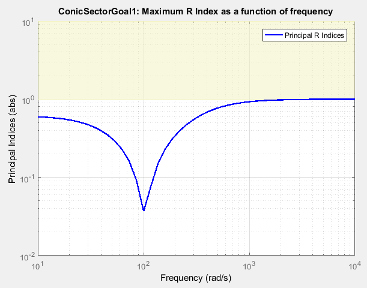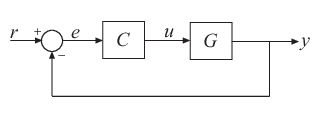円錐セクター目標
目的
制御システム調整器を使用する場合は、特定の入力/出力マップのセクター境界を適用します。
説明
円錐セクター目標は、システムの出力軌跡を制限する制約を作成します。すべての非ゼロ入力軌跡が u(t) の場合、線形システム H の出力軌跡 z(t) = (Hu)(t) は次を満たします。
すべての T ≥ 0 について上記が成り立ち、H の出力軌跡は、対称不定行列 Q で記述された円錐セクターに収まります。異なる Q 行列を選択すると、システムの応答に異なる条件が課されます。円錐セクター目標を作成する場合、入力信号、出力信号、セクターの形状を指定します。

制御システム調整器のプロットの影付き領域は、調整目標が満たされない周波数領域を表しています。プロットにはセクター境界とセクター インデックスについてで説明されている R インデックスの値が示されます。
作成
制御システム調整器の [調整] タブで、[新規目標] 、 [円錐セクター目標] を選択します。
コマンド ラインにおける同等の操作
コマンド ラインで制御システムを調整する場合、TuningGoal.ConicSector を使用してステップ応答目標を指定します。
I/O 伝達選択
ダイアログ ボックスのこのセクションを使用して、調整目標が制約する伝達関数の入力と出力を指定します。また、調整目標を評価するためにループを開く位置を指定します。
入力信号の指定
調整目標によって制約される伝達関数への入力として、モデル内の信号の位置を 1 つ以上選択します。SISO 応答を制約するには、単一値の入力信号を選択します。たとえば、
'u'という名前の位置から'y'という名前の位置にゲインを制約するには、 [信号をリストに追加] をクリックして
[信号をリストに追加] をクリックして 'u'を選択します。MIMO 応答の受動性を制約するには、複数の信号またはベクトル値の信号を選択します。出力信号の指定
調整目標によって制約される伝達関数の出力として、モデル内の信号の位置を 1 つ以上選択します。SISO 応答を制約するには、単一値の出力信号を選択します。たとえば、
'u'という名前の位置から'y'という名前の位置にゲインを制約するには、 [信号をリストに追加] をクリックして
[信号をリストに追加] をクリックして 'y'を選択します。MIMO 応答の受動性を制約するには、複数の信号またはベクトル値の信号を選択します。次の開ループの入力/出力ゲインの計算
この調整目標を評価するために、フィードバック ループを開くモデル内の信号の位置を 1 つ以上選択します。調整目標は、特定した位置でフィードバック ループを開くことにより作成される開ループの構成に対して評価されます。たとえば、
'x'という名前の位置が開始点の調整目標を評価するには、 [信号をリストに追加] をクリックして、
[信号をリストに追加] をクリックして、'x'を選択します。
ヒント
Simulink® モデル内で選択された任意の信号を強調表示するには、![]() をクリックします。入力リストまたは出力リストから信号を削除するには、
をクリックします。入力リストまたは出力リストから信号を削除するには、 をクリックします。複数の信号を選択した場合、
をクリックします。複数の信号を選択した場合、 および
および  を使用してそれらの信号を並べ替えることができます。調整目標のために信号の位置を指定する方法の詳細については、対話型調整の目標の指定を参照してください。
を使用してそれらの信号を並べ替えることができます。調整目標のために信号の位置を指定する方法の詳細については、対話型調整の目標の指定を参照してください。
オプション
ダイアログ ボックスのこのセクションを使用して、円錐セクター目標の追加の特性を指定します。
円錐セクター行列
セクターの形状 Q を入力します。次のように指定します。
定数のセクター形状の場合は行列。
Qは 1 辺がnyの対称正方行列です。ここで、nyは目標に指定した出力信号の数です。行列Qは適切に定義された円錐セクターを表すために不定でなければなりません。不定行列には、正と負両方の固有値があります。特に、Qは多くの負の固有値をもたなければなりません。これは、調整目標 (ベクトル入力信号 u(t) のサイズ) に指定された入力信号があるためです。周波数依存のセクター形状の場合は LTI モデル。
Qは Q(s)’ = Q(–s) を満たします。つまり、Q(s) は各周波数でエルミート行列と評価されます。
詳細については、セクター境界とセクター インデックスについてを参照してください。
正則化
正則化パラメーター。実数で非負のスカラー値として指定します。他の調整目標ではセクター境界が一部の周波数において悪条件となりやすい場合、正則化によって、調整目標の評価を数値的に処理しやすい状態に保ちます。このような条件が発生する場合、[正則化] を H の直達項の通常のノルムの小さい (ただし、無視できない) 割合に設定します。たとえば、調整中に H の直達項のノルムが次数 1 になると予想される場合、[正則化] を 0.001 に設定してみます。
正則化が必要となる条件の詳細については、
TuningGoal.ConicSectorのRegularizationプロパティを参照してください。周波数範囲の目標を適用
調整目標の適用を特定の周波数帯域に制限します。周波数帯域をモデルの周波数単位で表した形式
[min,max]の行ベクトルとして指定します。たとえば、1 ~ 100 rad/s のみに適用される調整目標を作成する場合は、[1,100]と入力します。既定では、調整目標は連続時間の場合はすべての周波数、離散時間の場合はナイキスト周波数以下の周波数に適用されます。目標を適用
たとえば、Simulink モデルを異なる操作点またはブロックパラメーター値で線形化することによって得られるモデルの配列などの複数のモデルを同時に調整している場合、このオプションを使用します。既定では、アクティブな調整目標がすべてのモデルに適用されます。調整要件を配列内の一部のモデルに適用するには、[モデルのみ] を選択します。次に目標を適用するモデルの配列インデックスを入力します。たとえば、モデル配列の中の 2 番目、3 番目、4 番目のモデルに調整目標を適用する必要があると仮定します。要件の適用を制限するには、[モデルのみ] テキスト ボックスに
2:4と入力します。複数モデルの調整の詳細については、Robust Tuning Approaches (Robust Control Toolbox)を参照してください。
ヒント
円錐セクターに対する入力軌跡および出力軌跡の制約
次の制御システムについて考えます。

信号 u は、調整しているモデルの解析ポイントとしてマークされているものと仮定します。また、G が u から y への閉ループ伝達関数であると仮定します。一般的な使用例では、以下を満たすために、G のすべての I/O 軌跡 {u(t),y(t)} を制限する調整目標を作成します。
すべての T ≥ 0 について上記が成り立つとします。G の I/O 軌跡を制約することは、システム H = [G;I] の出力軌跡 z(t) を次のように定義されたセクターに制限することと等価です。
(この等価性の詳細についてはセクター境界とセクター インデックスについてを参照)。円錐セクター目標を使用してこのタイプの制約を指定するには、入力信号として u を指定し、出力信号として y および u を指定します。u を入力および出力の両方で指定する場合、円錐セクター目標は対応する伝達関数をその単位行列に設定します。したがって、目標が制約する伝達関数は、意図したとおり H = [G;I] となります。この処理は円錐セクター目標に固有です。他の調整目標の場合、同じ信号が入力と出力両方に表示される場合、結果の伝達関数はフィードバック ループがない場合はゼロとなり、それ以外の場合はその位置の相補感度となります。この結果が生じるのは、ソフトウェアで解析ポイントを処理するときに、入力が出力後に挿入されることを前提にしているためです。解析ポイントの機能の詳細については、制御システムの解析と設計における対象信号のマークを参照してください。
アルゴリズム
次のように仮定します。
これは Q の不定分解で、 です。 が正方で最小位相である場合、時間領域セクター境界は次のようになります。
これは、次の周波数領域のセクター条件と同等です。
すべての周波数について上記が成り立ちます。円錐セクター目標でこの等価性を使用して、時間領域の特性を、制御システム調整器でゲインの制約を処理するのと同様に処理できる周波数領域条件に変換します。また、この等価性を確保するために、円錐セクター目標は、すべての零点を安定させることで を最小位相にします。この最小位相条件によって影響を受ける伝達零点は、この調整目標の "安定ダイナミクス" です。[最小 decay 率] と [最大固有振動数] の調整オプションは、これらの暗黙的に制約されるダイナミクスの下限と上限を制御します。最適化が既定の制限を満たしていない場合、または既定の制限が他の要件と競合している場合、[調整] タブで [調整オプション] を使用して既定の設定を変更します。
セクター境界で、R インデックスはピーク ゲインがゲインの制約に対して行うのと同じ役割を果たします (セクター境界とセクター インデックスについてを参照)。次の条件は、
R インデックスが 1 未満の場合にのみ、すべての周波数で満たされます。制御システム調整器が円錐セクター目標に表示するプロットには、R インデックスの値が周波数の関数として示されます (sectorplot を参照)。
制御システムを調整するときに、各調整目標は正規化されたスカラー値 f(x) に変換されます。ここで x は、制御システムの自由 (調整可能) パラメーターのベクトルです。その後、ソフトウェアはパラメーター値を調整して f(x) を最小化するか、調整目標が厳密な制約値の場合、f(x) が 1 より小さくなるようにします。
[円錐セクター目標] では、指定した入力から出力への閉ループ伝達関数 H(s,x) の場合、f(x) は次のようになります。
R は、Q で表されるセクターの相対的なセクター インデックス H(s,x) です (getSectorIndex を参照)。